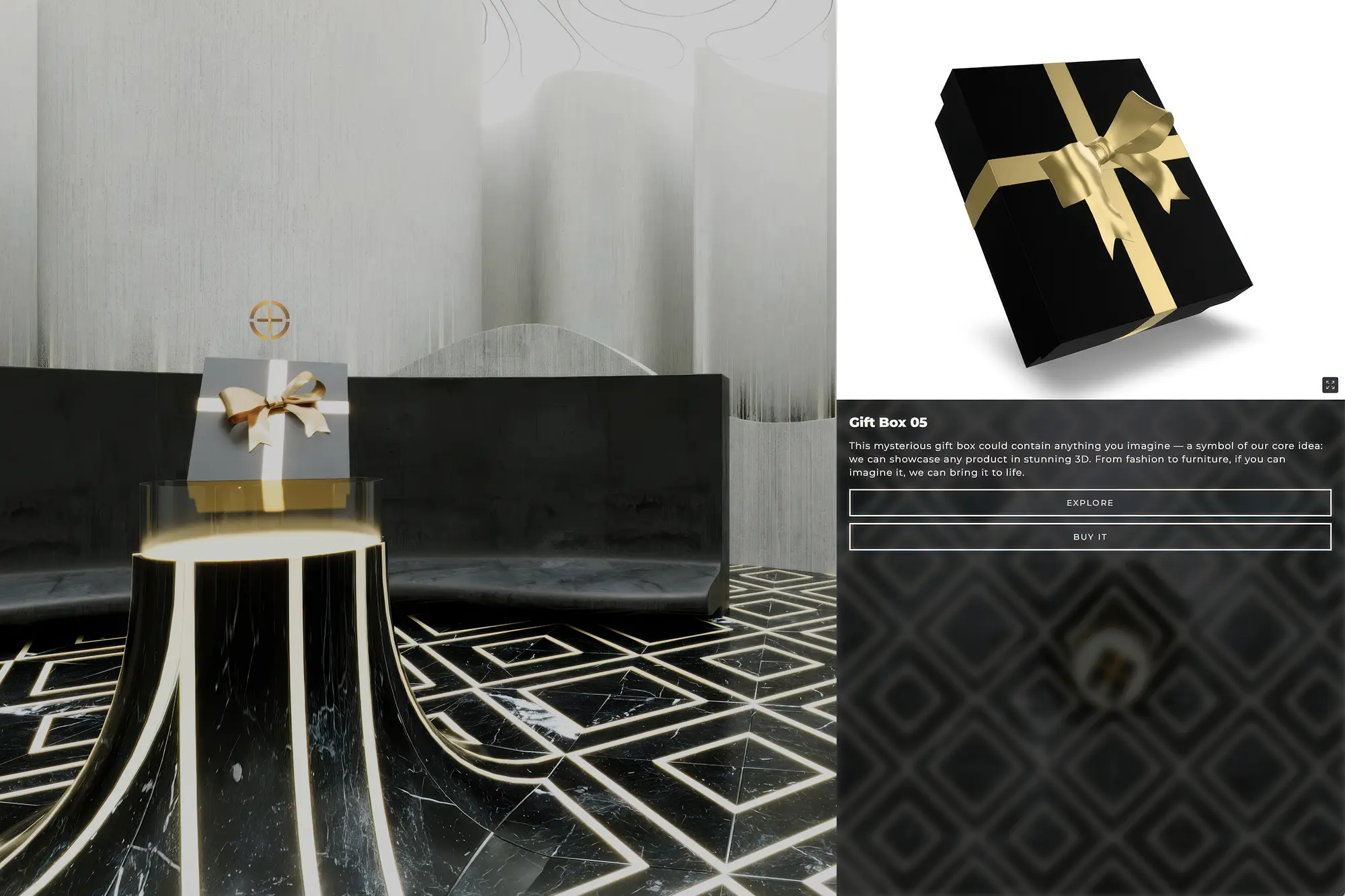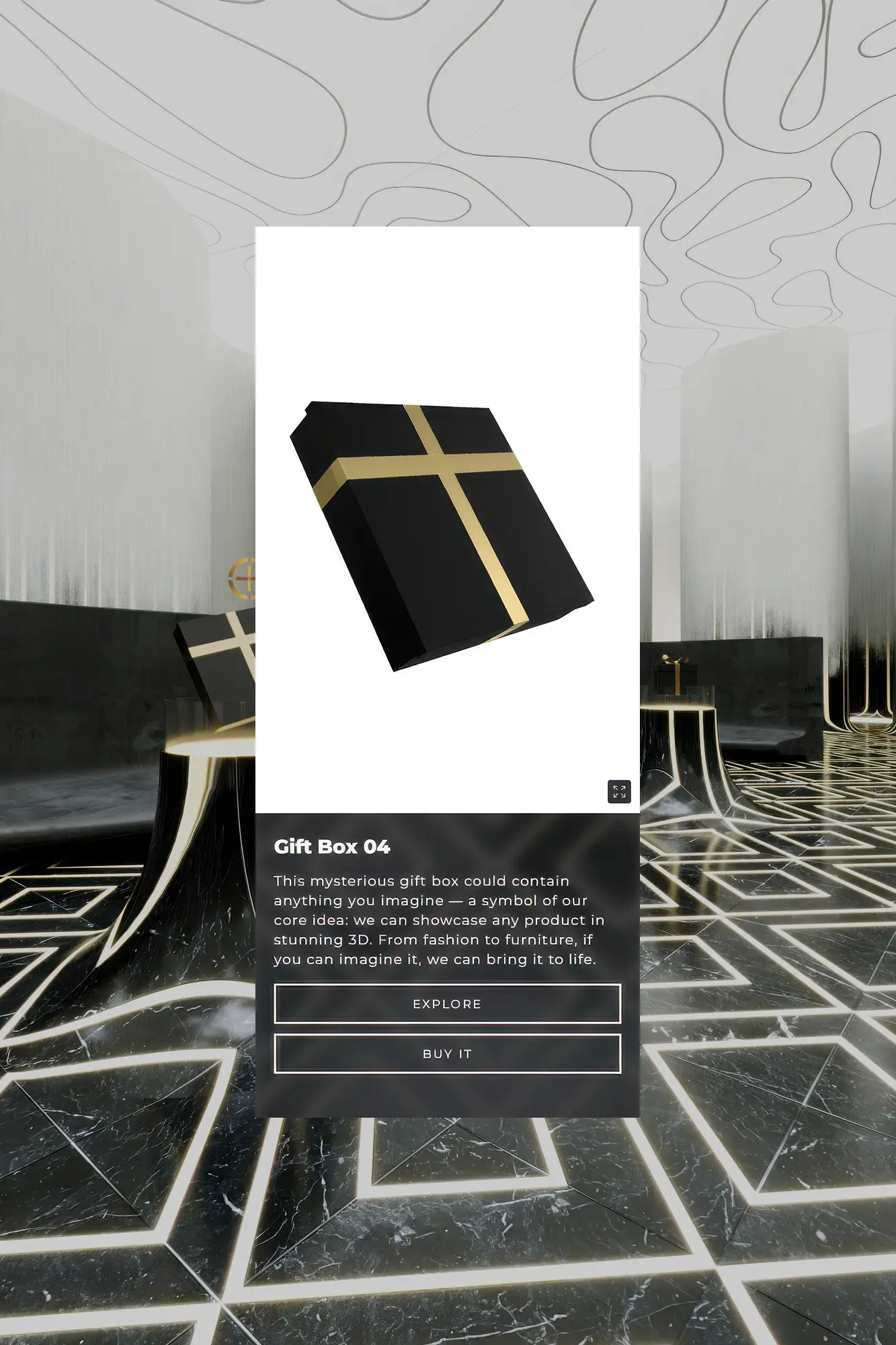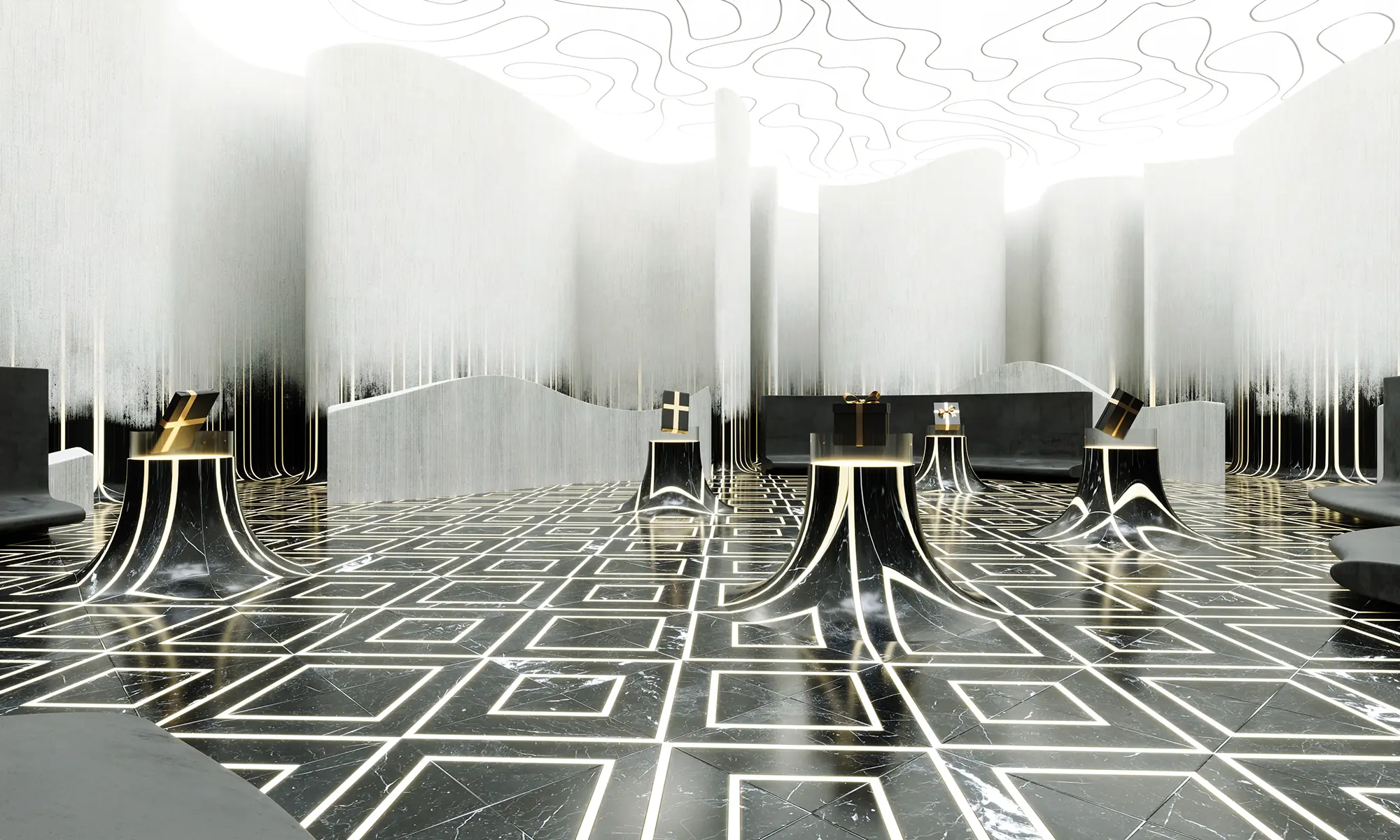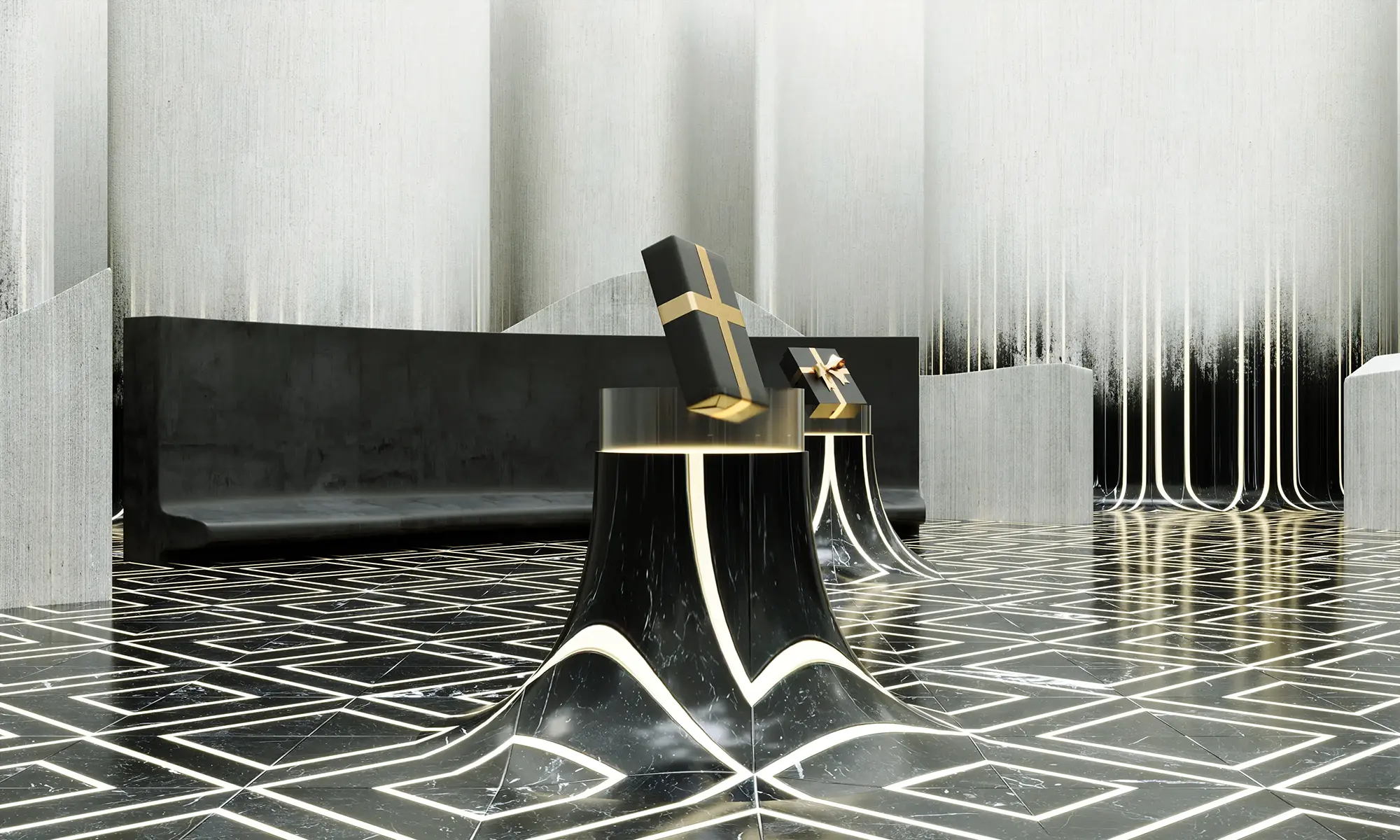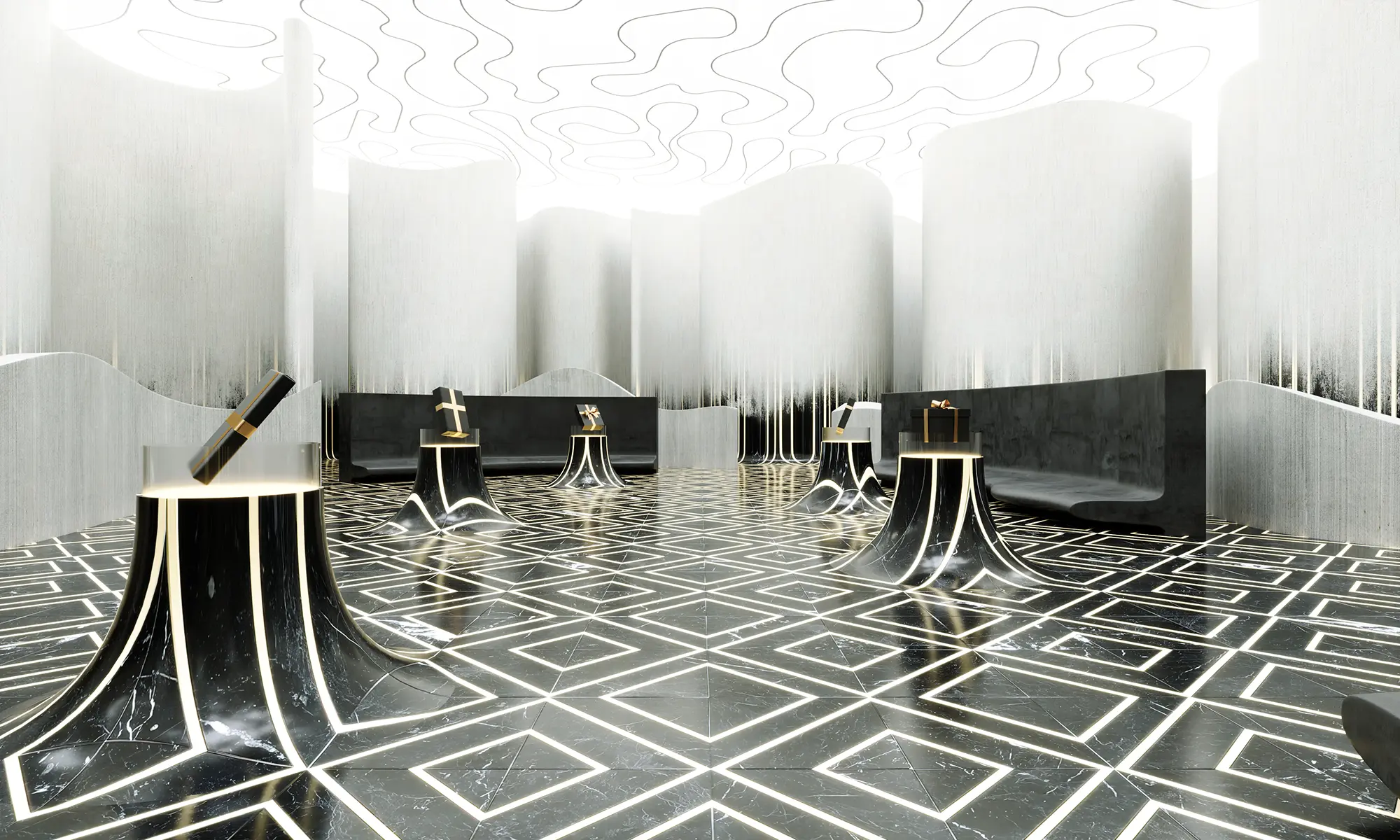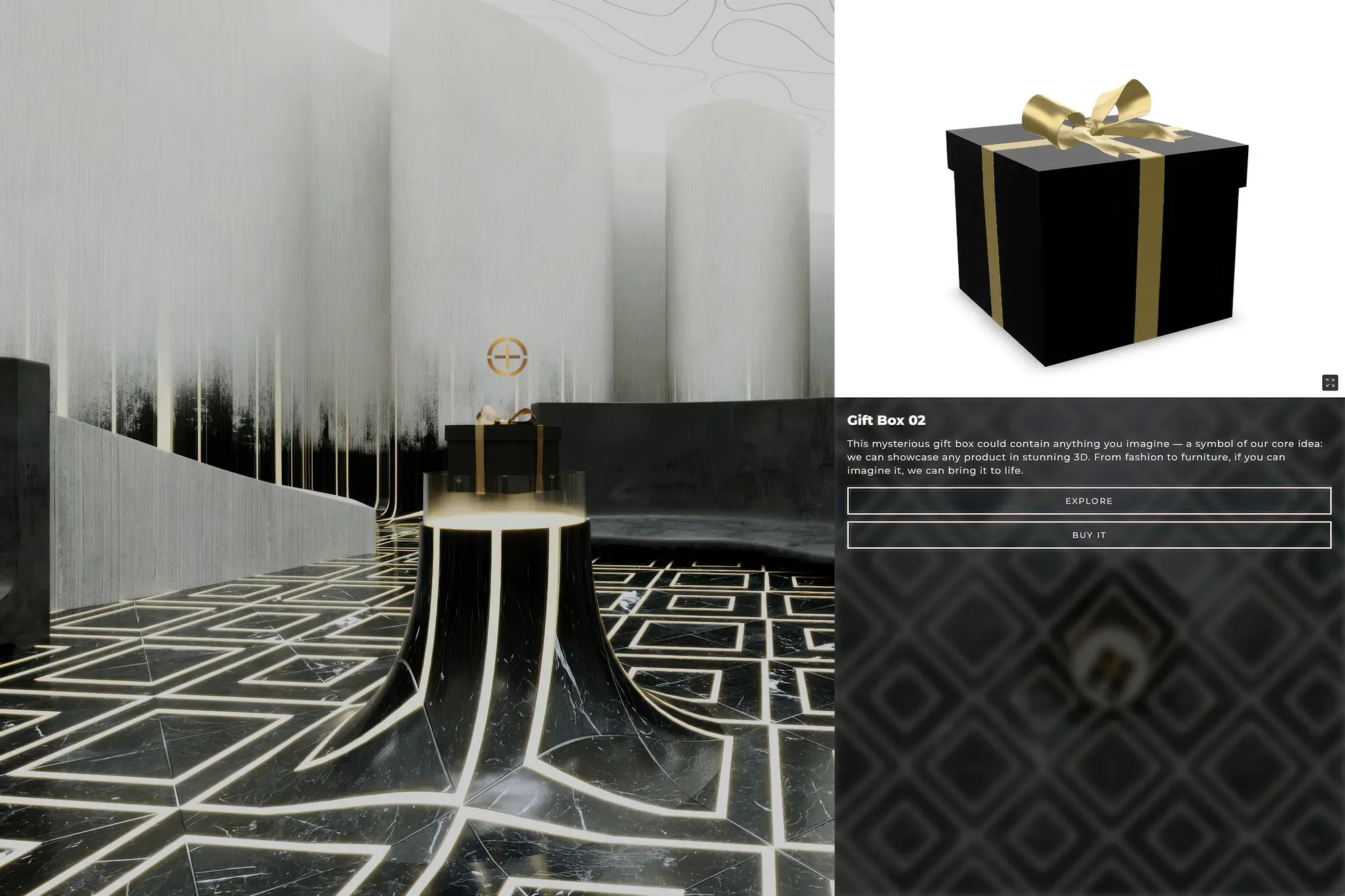Virtual Store
⁃ Immersive 3D shopping experience
⁃ Accessible on mobile, tablet, and desktop
⁃ Showcase product variants and details before purchase
Key Features
Gallery
Applications
Digital Showrooms
Transforming Shopping Experiences Online
Virtual stores are the next generation of e-commerce and Web3 development. A virtual store is a place where a product can be seen not only in a photo, video, or even a 3D model. Customers can examine it from all sides in a natural environment, just like in a regular showroom. For the buyer, it is an opportunity to learn everything possible about the product and even “try it on” in the comfort of their home. For businesses, it means higher levels of engagement and conversion, which positively affect financial results.
Virtual stores are among the priority areas of e-commerce development. Today, real industry leaders, such as Nestle, Unilever, Disney, Volkswagen, Sony, and others, are actively working on creating digital showrooms. They are looking for unique ways of development and are constantly experimenting with new methods of implementing advanced technology.
Virtual stores are a perfect fit for the Web3.0 concept as they form a comprehensive experience of interaction with a product. They don’t just allow you to show a product or talk about its benefits but give potential customers the opportunity to interact with it in a digital environment that simulates certain life situations. Today, virtual store technology is becoming more immersive, realistic, and accessible to a wider business audience. And the contribution of 100CGI to this process is substantial.
Industries Embracing Virtual Stores and Their Advantages
Virtual online stores are versatile enough to be adapted to various industries. Each of them receives unique benefits from the use of new technologies. Let’s talk about it in more detail.
Fashion and Apparel
Classic online clothing and footwear stores have one significant drawback: you can view the product but cannot try it on. 3D virtual stores solve this problem by creating a comprehensive experience. They can become a digital fitting room, a catwalk, or any other environment that will fully reveal the benefits of the product. A customer can see how clothes or shoes look in certain lighting, how they are combined with other wardrobe items. Moreover, it only takes one click or one hand movement to choose the right color, print, or size. This approach reduces the high rate of returns due to incorrect size or fit, a common challenge for online fashion retailers. For brands, virtual stores help create a personalized environment where every element emphasizes their value. This is relevant to any fashion trend, from haute couture boutiques to casual wear shops.
Furniture and Interior Design
Choosing furniture online can be tricky because photos don’t give the buyer a complete picture of what a piece of furniture looks like, how it will match certain interior styles, or what distinguishes certain models. To overcome this problem, you should move from the website to a 3D virtual store. A digital showroom allows you to view furniture from any angle and select unique design combinations according to the client’s needs. In this space, you can see all the available options and get detailed information about each of them. It looks like you are flipping through Pinterest pages but with the ability to order the perfect furniture for your interior in one click.
Automotive
Virtual car dealerships were among the first points of sale of this kind. They allow customers to explore car models in great detail, viewing everything — from the interior layout to the vehicle’s exterior finish — without visiting a dealership. You don’t have to travel to another city or wait several weeks to see a vehicle in a different color or configuration — just click or tap on the touch screen. This significantly expands the market reach and allows automotive brands to connect with a wider audience, especially those who may not be able to visit a physical showroom. Virtual car dealerships also allow you to create a unique presentation that would be impractical or even impossible in the real world, for example, to show the technical basis of a car in a section, demonstrate the differences between engines and transmissions in different versions, etc. Modern technologies make it possible to show all this in dynamics, similar to the animation of tuning in computer games.
Real Estate
Can you buy an apartment or a house in a virtual store like you shop in a supermarket? This is no longer the future — it’s our everyday reality. Potential buyers and renters can experience a 3D walkthrough of properties from their devices, an option that has gained traction recently due to limitations in in-person viewings. Virtual tours make it possible to feel like a future owner rather than just a buyer — to evaluate the layout, try on approximate arrangements of furniture and appliances, measure distances in steps, etc. For clients, this saves time, resources, and effort, relieving the anxiety associated with moving. For real estate agencies, it is a serious competitive advantage.
Beauty and Cosmetics
Virtual stores work effectively even in this area, creating a comprehensive experience of interaction with the product. They allow you to see how certain products look on your skin — whether they match your skin tone, go well with your makeup, etc. In today’s digital outlets, you can even adjust the lighting to see your look on the street, at work, at home, in a nightclub, or in a restaurant. The virtual store environment for beauty products elevates the shopping experience, giving customers confidence in their choices and encouraging repeat purchases.
Key Features of a Virtual Store
To create virtual store and make it a success, you need to take care of its functionality. The main features designed to replicate or enhance the traditional shopping experience are as follows:
- Interactive Product Displays. It is a key element of a virtual store. The displays allow you to rotate products to view them from different angles, zoom in and out, and move them around.
- Personal assistant. A 3D AI-powered avatar that acts as a consultant. It provides a perfect customer experience by providing unobtrusive tips, solving complex issues, and accompanying you on the way to conversion.
- Customized environments. Virtual stores allow brands to craft immersive digital spaces that mirror their identity, aesthetics, and values. The advantage of digital space is that this environment can be customized to the brand and the user’s preferences, ensuring maximum engagement through hyper-personalization.
- Hotspots. Elements that connect the virtual space with the real online store or company software. These interactive points allow users to access detailed product information, videos, or even purchase options with a simple click or tap. Whether it’s viewing a product’s specs or adding it directly to the cart, hotspots ensure that every interaction is intuitive and fluid.
- Multi-Device Support. It is crucial to ensure that every customer, no matter what device or operating system they use, has access to the virtual store. This may require implementing fundamentally different technologies, for example, adapting to virtual reality headsets or touch screens of classic smartphones.
Technologies Powering Virtual Stores
What exactly do you need to move e-commerce online and achieve the desired results? Currently, standardized virtual store platforms are at an early stage of development, so you’ll have to start from scratch. And you should focus on the following technologies:
- 3D Visualization. 3D models have been and remain the basis of all immersive sales systems. Today’s applications that use new rendering technologies and AI make them almost tangible. They enable the accurate reproduction of small products that require close examination, such as jewelry, furniture, and electronics.
- Extended Reality (XR) — AR+VR. Virtual reality makes it possible to conduct full-fledged virtual store tours. Wearing special headsets, customers can walk through stores and interact with products as they would in a physical setting. Augmented reality is a more practical solution. It overlays images of digital objects on the image of the world around us, which is highly relevant in many industries, especially the furniture, cosmetics, and fashion industries.
- Personalized Recommendations. The latest AI algorithms can predict the needs and desires of customers as soon as they open a page in a browser. They improve the user experience and significantly increase key business success metrics, making virtual stores not just copies of physical outlets but their improved versions.
Building a Virtual Store with 100CGI
Virtual stores are among the top products of our studio. Currently, we are actively developing this area and paying more and more attention to innovative projects created in collaboration with well-known brands. But our services remain affordable, enabling you to put new technologies to work ahead of your competitors and gain serious advantages.
Why should you order VR stores from 100CGI? There are several reasons for this:
- The use of the best 3D software for virtual stores, providing an incredible level of detail;
- Close cooperation with each client to find an individual approach to the realization of a creative idea;
- Reflection of the company’s business model in the virtual store to improve user experience and simplify workflows;
- Punctuality in work performance — we always meet the agreed deadlines and fulfill our obligations;
- Comprehensive support of VR stores after the work is completed — solving current problems, edits, upgrades, etc.
The Future of Shopping
The spread of virtual stores is the first step toward the digital retail of the future, where brands can deliver experiences close to in-person shopping. They have proven effective in various industries, from fashion and furniture to automotive and beauty. The reasons for their popularity are incredible user-friendliness, high level of personalization, and immersive experiences.
100CGI’s expertise in 3D modeling and creating high-quality digital products allows brands to use this technology effectively. By creating unique interactive shopping environments, we help clients connect with their customers, meeting and exceeding consumer expectations. Embrace the future of shopping with 100CGI — contact us to discuss the details of your project and get a quote.
Frequently Asked Questions
-
What is a virtual store?
-
A virtual store is a digital shopping environment that simulates a physical retail space. It allows customers to browse and purchase products online, often using 3D models or virtual reality (VR) technology. Unlike traditional e-commerce websites, virtual stores aim to replicate the in-store experience, offering immersive navigation and interactive product engagement.
-
-
What is the difference between online store and virtual store?
-
An online store is typically a website displaying products in a catalog format, focusing on functionality and convenience. A virtual store, on the other hand, replicates a physical shopping environment using 3D or VR technology. It allows customers to "walk through" the space, interact with items, and enjoy a more immersive and realistic shopping experience.
-
-
How to create a 3D virtual store?
-
To create a 3D virtual store, start by designing a digital 3D model of your physical space or layout. Use tools like Unity, Unreal Engine, or WebGL platforms. Integrate interactive elements, product models, and navigation features. Finally, deploy it online or through VR headsets, ensuring it's mobile and desktop compatible for accessibility and user convenience.
-
-
What are the benefits of a virtual reality store for businesses?
-
Virtual reality stores enhance customer engagement, improve brand perception, and offer unique, memorable shopping experiences. They allow businesses to showcase products in innovative ways, reduce physical store costs, and gather valuable customer behavior insights. VR stores also attract tech-savvy consumers, differentiate brands, and offer global reach without geographic limitations, increasing sales opportunities.
-
-
How does a virtual store tour work for customers?
-
Customers access a virtual store tour via a website, mobile device, or VR headset. They navigate the digital environment using clicks, gestures, or controllers. As they "walk through," they can view products, interact with displays, read descriptions, and add items to their cart—simulating a real-life shopping trip with immersive, interactive elements.
-
-
What industries can benefit most from a VR store experience?
-
Retail, fashion, real estate, automotive, furniture, and tourism industries benefit greatly from VR stores. These sectors rely on visual and experiential appeal, which VR enhances. For example, furniture stores can show how items look in rooms, while fashion brands offer virtual try-ons. Real estate agents use VR to provide immersive property tours remotely.
-
-
Do virtual stores support interactive product displays and animations?
-
Yes, virtual stores often feature interactive product displays and animations to enhance user engagement. Shoppers can rotate, zoom, or customize products in 3D. Animations demonstrate product functionality or simulate real-life use. These features provide a deeper understanding of the product, reduce uncertainty, and can significantly influence purchase decisions through a more engaging experience.
-
How We’re Rated
Let's start new project.
Now, as you were able to get a picture of who we are, it is up to you to contact us and lay the foundation for a new and successful business relationship. Leave your contact information and our team will get in touch.

